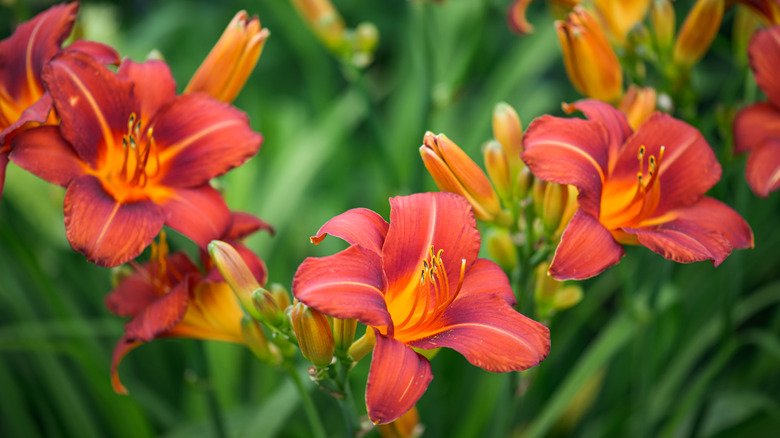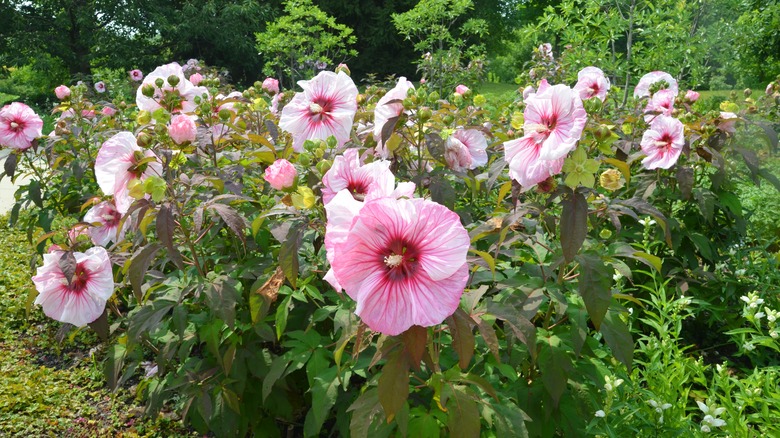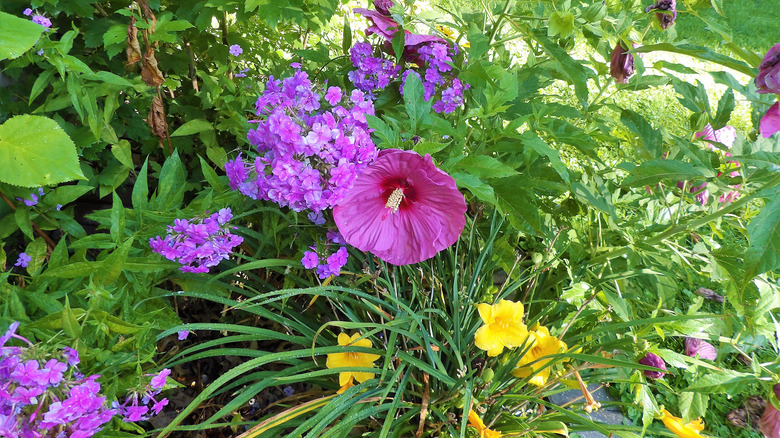Plant Daylilies Near These Colorful Flowers For A Thriving Garden
Daylilies are showstoppers in the garden. Even though each flower only blooms for a day, there are often so many colorful flowers that you barely notice how short-lived each bloom is. They also pair beautifully with the large tropical-looking blooms of hardy hibiscus.
Daylilies are beloved perennials in the Hemerocallis genus. They don't just have stunning flowers, daylilies also have interesting grass-like foliage, making them a boon to gardens even when not in bloom. While the classic daylily flower is trumpet-shaped, other flower types also exist, including fuller-looking doubles and even some with a spider-like shape. Some varieties are very fragrant as well. It isn't difficult to care for your daylilies and they have a well-deserved reputation for being low-maintenance. Daylilies flower best with at least six hours of sun and well-draining moist soil. They can grow in most soil types but prefer soil with slightly acidic pH. While different varieties are hardy in different zones, there are daylily options for growers in zones 3 through 9.
Hardy hibiscus is a perfect match for daylilies
Despite looking like they came straight from the tropics, hardy hibiscus (Hibiscus hybrid) are actually hybrids of hibiscus plants native to the South Eastern United States and are hardy in zones 4 through 9. With massive flowers that can get as big as 10 inches and beautiful glossy leaves, hardy hibiscus are stunners in the garden. In addition to being hummingbird magnets, they're a big hit with pollinators who love their massive blooms. They are especially important to the rose-mallow bee, a bumble-bee-like insect native to the Eastern United States that evolved to feed primarily on hibiscus.
Hardy hibiscus, like the daylily, thrives in full sun and moist soil. Both plants also appreciate soil that drains well and has plenty of organic material mixed in. Unlike daylilies, hardy hibiscus plants grow best in alkaline soil with a pH above 8. Luckily, daylilies are not overly particular about their soil pH, so they should still grow well near hibiscus.
How to combine daylilies and hardy hibiscus
Hardy hibiscus often dies back to its roots over winter and may not break dormancy until late May, but once it does, it can quickly grow several feet. While there are smaller cultivars now available, they still generally reach at least 3 feet tall. In contrast, daylilies' green grassy foliage starts growing by mid-spring for most varieties. There are even some evergreen daylily varieties that can be grown in warmer zones. While there are varieties that can grow taller than 3 feet, most daylilies are shorter, and planting them in front of hardy hibiscus will provide some spring interest while waiting for the hibiscus to wake up.
Both daylilies and hardy hibiscus are available in a variety of colors. Daylilies can range from pinks and purples to oranges, yellows, and even whites. Hardy hibiscus similarly comes in shades of pinks, whites, reds, and purples. While most varieties have green leaves, there are also types with burgundy foliage. Depending on your style, daylilies and hardy hibiscus can be paired to create a variety of looks, from a monochromatic all-white planting to mixing pinks, reds, and purples for a complementary palette. You can also mix unexpected flower colors to create bold looks with plenty of contrast.


